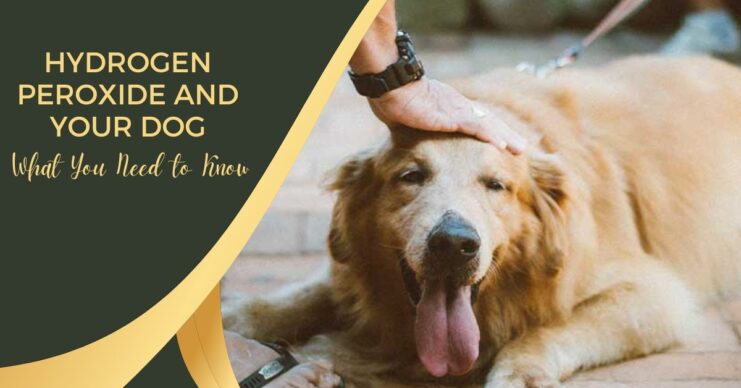Many individuals know that inducing vomiting in dogs with hydrogen peroxide is possible. However, using hydrogen peroxide can have potential complications, and other options are available.
Hydrogen peroxide induces vomiting by irritating the mouth, esophagus, and stomach lining. Mild side effects of hydrogen peroxide ingestion may include ongoing vomiting or a lack of appetite.
In such cases, the affected animal is typically treated with antacids and stomach protectants until the digestive system heals.
In rare instances, however, the side effects can escalate beyond mild irritation. Severe gastritis, or stomach inflammation, can develop, leading to ulceration and bleeding. Although extremely uncommon, some pets have died due to internal bleeding caused by hydrogen peroxide toxicity.
Rare Side Effects and Safer Alternatives
A rare but potential side effect of hydrogen peroxide ingestion is gas embolism, an air clot in blood vessels. When hydrogen peroxide reacts with tissue, it releases oxygen. This excess gas release can be absorbed by inflamed stomach tissue, leading to this potentially fatal complication.
There are safer alternatives for inducing vomiting in dogs. Veterinarians often administer a medication called apomorphine, which effectively induces vomiting. This medication is given intravenously or as a small tablet placed under the lower eyelid for absorption. Instead of causing inflammation in the stomach, the drug stimulates the brain’s nausea centers, resulting in vomiting.
It is generally safer to bring your dog to a veterinarian if they have ingested something toxic, rather than inducing vomiting at home. However, there may be situations where the risks of not inducing vomiting outweigh the risks of gastrointestinal irritation from hydrogen peroxide.
If your pet has consumed an extremely toxic substance, such as rat poison, and you cannot get your dog to a veterinary clinic promptly, using hydrogen peroxide may be a better option than allowing the poison to be absorbed. Since there might be emergency situations where hydrogen peroxide is a better choice than not inducing vomiting at all, it is crucial to know the proper way to use hydrogen peroxide.
Key Points for Using Hydrogen Peroxide Safely

It’s essential to never use hydrogen peroxide with a concentration higher than 3 percent. For instance, 10 percent hydrogen peroxide is highly corrosive to the gastrointestinal lining and should never be used.
The dosage of 3 percent hydrogen peroxide is 1 milliliter per pound of dog weight. For example, a 20-pound dog would require 20 milliliters of hydrogen peroxide, which is approximately 4 teaspoons.
If vomiting has not occurred within 15 minutes after administering hydrogen peroxide, you may give one more dose. However, do not continue giving your dog hydrogen peroxide if they are not vomiting, as this could result in an overdose and hydrogen peroxide toxicity. It’s important to note that not all dogs will vomit when given hydrogen peroxide.
Situations When Inducing Vomiting is Not Recommended
There are instances when inducing vomiting is not advised, such as when your pet is having seizures or is extremely lethargic due to the ingested toxin. In these cases, the animal is at a high risk of aspirating hydrogen peroxide.
Additionally, if your pet has swallowed sharp objects, inducing vomiting may pose a risk of these items becoming lodged in the esophagus.
It’s crucial to note that hydrogen peroxide should never be given to a cat.
If you suspect your pet has consumed a potentially toxic substance, it’s essential to contact your veterinarian or the Pet Poison Helpline at 1-855-764-7661 for advice (note that there is a fee for the helpline). In some cases, the ingested substance may have mild effects or be in small enough doses that vomiting isn’t necessary.
Understanding the correct guidelines for using hydrogen peroxide on your dog is crucial. However, even with the best intentions, complications can arise. If your dog shows elevated alkaline phosphatase levels, it could indicate a more significant health concern.
When to Seek Emergency Veterinary Care for Your Pet

Recognizing the signs of a pet emergency and knowing when to seek immediate veterinary care can be crucial for your pet’s health and well-being. Here are some situations and symptoms that may warrant emergency veterinary care:
- Severe trauma or injury: If your pet has been hit by a car, fallen from a significant height, or sustained a serious injury, seek emergency care immediately. Even if your pet appears to be okay, internal injuries could be life-threatening.
- Difficulty breathing: If your pet is struggling to breathe, has a rapid or shallow breathing pattern, or is coughing excessively, it could indicate a severe respiratory issue that requires immediate attention.
- Seizures: A single seizure could be a sign of an underlying health issue, while multiple seizures or prolonged seizure activity may indicate a more serious condition. Seek emergency care to ensure your pet receives appropriate treatment and management.
- Loss of consciousness or collapse: If your pet loses consciousness or collapses, it could be a sign of a life-threatening issue such as heart failure, poisoning, or shock.
- Ingestion of toxins: If you suspect your pet has ingested a toxic substance (e.g., rat poison, antifreeze, chocolate, xylitol, etc.), contact your veterinarian or the Pet Poison Helpline immediately for advice on the next steps.
- Severe vomiting or diarrhea: If your pet is experiencing severe, persistent vomiting or diarrhea, it could lead to dehydration or indicate a more serious underlying condition.
- Signs of extreme pain: If your pet is showing signs of severe pain, such as excessive vocalization, panting, shaking, or an inability to get comfortable, seek veterinary care to address the issue and provide pain relief.
- Bleeding: Uncontrolled bleeding or bleeding that doesn’t stop within five minutes may require emergency care to prevent blood loss and identify the cause.
- Swollen or distended abdomen: A swollen or distended abdomen could be a sign of a life-threatening condition such as bloat (gastric torsion) or internal bleeding.
- Eye injuries: Eye injuries can worsen quickly and potentially lead to vision loss. Seek emergency care to address any eye injuries and prevent further complications.
- Severe allergic reactions: If your pet is experiencing facial swelling, difficulty breathing, or hives, they may be having a severe allergic reaction that requires immediate treatment.
- Inability to urinate or defecate: If your pet is unable to pass urine or feces for an extended period or shows signs of straining, they could be experiencing a blockage that requires urgent attention.
FAQ

What are some common household toxins that can harm my pets?
Some common household toxins that can be harmful to pets include human medications (such as painkillers, antidepressants, and cold medicines), cleaning products (like bleach and ammonia), insecticides, rodenticides, certain plants (such as lilies, azaleas, and sago palms), chocolate, xylitol (a sugar substitute), and antifreeze. Make sure to keep these items out of reach of your pets, and always store them safely in closed cabinets or drawers.
Are there any alternative home remedies for inducing vomiting in dogs besides hydrogen peroxide?
While hydrogen peroxide is the most commonly recommended home remedy for inducing vomiting in dogs, there are some alternatives. However, these alternatives may not be as effective as hydrogen peroxide, and it is still best to consult with a veterinarian before administering any home remedies. Some alternatives include salt water, mustard, and syrup of ipecac. Note that these alternatives can also have side effects and may not be suitable for all dogs or situations. Always consult your veterinarian before attempting to induce vomiting in your dog at home.
Are there any alternative home remedies for inducing vomiting in dogs besides hydrogen peroxide?
While hydrogen peroxide is the most commonly recommended home remedy for inducing vomiting in dogs, there are some alternatives. However, these alternatives may not be as effective as hydrogen peroxide, and it is still best to consult with a veterinarian before administering any home remedies. Some alternatives include salt water, mustard, and syrup of ipecac. Note that these alternatives can also have side effects and may not be suitable for all dogs or situations. Always consult your veterinarian before attempting to induce vomiting in your dog at home.
Conclusion
In conclusion, being aware of the potential dangers and risks to your pet’s health is crucial for ensuring their well-being. Understanding when to induce vomiting and when to seek emergency veterinary care can make all the difference in your pet’s recovery. Always consult with your veterinarian or the Pet Poison Helpline for advice in cases of potential toxicity or emergency situations, and keep your home as safe as possible to minimize the chances of accidents.

